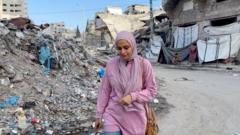The ancient city of Homs, once a stronghold against Assad's oppression, is now a landscape of devastation. Residents returning home find hope intertwined with sorrow as they navigate the wreckage of their past lives.
Homs Reflects on Destruction Amidst Assad's Fall

Homs Reflects on Destruction Amidst Assad's Fall
As President Bashar al-Assad's regime crumbles, Homs residents confront the scars of war and express mixed emotions.
In the aftermath of President Bashar al-Assad's fall, Homs, a city representative of the Syrian uprising, has become a stark reminder of the toll of years of civil war. Abdulrahman Alama, a former refugee who returned to Homs from Lebanon, surveyed the destruction of his childhood home with disbelief. “It’s shocking, really shocking,” he articulated, unwilling to share photographs of the devastation with his father back in Lebanon, deeming it too distressing.
As thousands of Syrians—including refugees and former detainees—return to their homeland, Homs has become a focal point for contrasting emotions. Amidst ruins, locals express gratitude for their freedom while simultaneously mourning the loss inflicted during Assad's violent crackdown on dissent. Abdulrahman was not alone in his mixed feelings; many residents could be seen smiling through tears, revealing a complex tapestry of hope and heartbreak.
Homs was at the heart of the resistance against Assad's regime when protests first escalated in 2011, turning it into a battleground defined by brutal assaults and heavy bombardment. The neighborhood of Baba Amr, where Abdulrahman stood amid rubble, had frequently faced relentless military attacks aimed at quelling the spirit of rebellion. Now, with the regime's fall, these neighborhoods are scenes of reflection for those who endured years of oppression.
Returning residents are beginning to embrace a different reality, one free of the long shadow cast by dictatorship, but the path to rebuilding their lives remains uncertain. As they pick through the remnants of their homes, the significance of their journey is palpable: it signifies both the end of a nightmarish chapter and the beginning of a complex process of recovery and renewal in a city that has paid a heavy price for freedom.


















